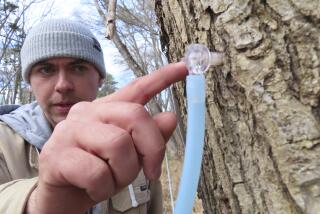DRINK : Cider: the Apple of Our Eyes
- Share via
On a cold day in London, businessmen who don’t rush home for dinner often pop into a local pub and sip a hard cider before hopping on the tube. Ciders are a fast-growing segment of the drinks market in England, accounting for about 10% of all alcoholic beverages sold in pubs.
And now, almost overnight, cider is taking off in the United States--largely without fanfare. Indeed, the word “cider” itself isn’t well understood; many people believe that it refers to apple juice.
By definition, cider is fermented apple juice. It has 4% to 6.5% alcohol and generally some carbonation, so its fizz is not unlike that of beer, the product to which it is most often compared in England.
During the last several years, cider has grown faster than any other American alcoholic beverage category. Import figures, the only ones available from official sources, show that shipments grew 250% from 1988 to last year’s 335,000 cases.
And that was before the introduction three weeks ago of George Hornsby’s Pub Draft Cider to major U.S. markets. Hornsby’s product is expected to account almost immediately for as much as 20% of the market.
So who is George Hornsby? By any other name, he is Ernest Gallo, president of the world’s largest winery, which has a long history with apple products (remember Boone’s Farm Apple?).
Gallo doesn’t reveal sales figures, but beverage industry scuttlebutt is that Gallo has shipped more than 100,000 cases of Hornsby, thus instantly becoming the second-largest brand in the United States. And, insiders say, Gallo is prepared to spend many millions of dollars on an advertising campaign to introduce Hornsby this fall.
Apple cider has been made in many areas of the country, notably in Vermont and Oregon, for decades and is a little-regulated product because it usually isn’t taxed as an alcoholic beverage, even if it has alcohol.
However, its perishability and the difficulty of making it consistently fine made it an outcast in the alcoholic beverage community until 12 years ago, when Englishman Jeffrey House began to market Dry Blackthorn in the United States.
His efforts succeeded. Today, Dry Blackthorn has one-third of the U.S. cider market, and it is on tap in more than 200 locations in California alone.
House says ciders like this are targeted at the micro-brew crowd and as an alternative to coolers because they are not as sweet. They appeal mainly to those who don’t like totally dry beer.
He says the cider market really didn’t develop strongly in England until the 1960s, when some of the larger companies began to spend a lot of money on advertising.
“Cider wasn’t expensive,” he says, “so it was good for a young man who didn’t have a lot of money in his pocket to offer his lady a cider. There has been a 10% annual growth rate in England for the last 15 years.”
The labels of many ciders on shelves today include ingredient and nutrition lists, but few tell how cider is made. Generally, apple juice, usually from concentrate, is placed in a vat, yeast is added and the fermentation makes the liquid dry, in terms of sugar. More apple juice is added to blend back some sweetness and bring the alcohol under 7%. The cider is then carbonated.
One of the few ciders made entirely from fresh apples is called Ace, a new brand that House developed in Sonoma county’s depressed apple country around Sebastopol.
House hired former winemaker Dave Cordtz and leased space at Associated Vintage Group’s sparkling wine facility in Graton, amid the apple trees of Sebastopol.
Cordtz says he uses six different varieties of apples. He won’t name them (“It’s a secret blend”) but admits that he loves the local Gravensteins and Granny Smiths and uses some Fuji apples for complexity.
By year-end, 20,000 cases of Ace will have been produced, he says.
Ace makes two types: Ace Fermented Apple Cider is the primary product, but a new addition to the line, called Fermented Pear Cider, is taking off so fast that Cordtz can’t make it fast enough.
Strictly speaking, there is no such thing as a pear cider. Fermented pear juice makes a product called perry, but House felt that because his “pear cider” actually is a blend of apples and pears and because few Americans know the term perry, he could get away with the misnomer.
“Frankly, we’re very excited about [Gallo] coming into the market to advertise and make a real category out of cider,” he says. “We want to represent the premium side of this business.”
Although Hornsby and Ace have been out for only a few weeks, a spokesman for Vons Markets in Los Angeles said, “We can’t keep them stacked on the floor. It’s flying out.”
Gallo will have company. The Nos. 2 and 3 producers of cider in England, Taunton and Matthew Clark, just announced plans to merge, and the new company has signed a joint venture with Miller Brewing Co. of the United States. The newly merged firm will market Miller Genuine Draft in England, and Miller will distribute Dry Blackthorn and some of Taunton’s premium ciders in the United States.
But the main target for the major cider companies is the pub with a United Kingdom lilt.
“An Irish pub without a cider is like a Chinese restaurant without noodles,” said House.
More to Read
Eat your way across L.A.
Get our weekly Tasting Notes newsletter for reviews, news and more.
You may occasionally receive promotional content from the Los Angeles Times.










